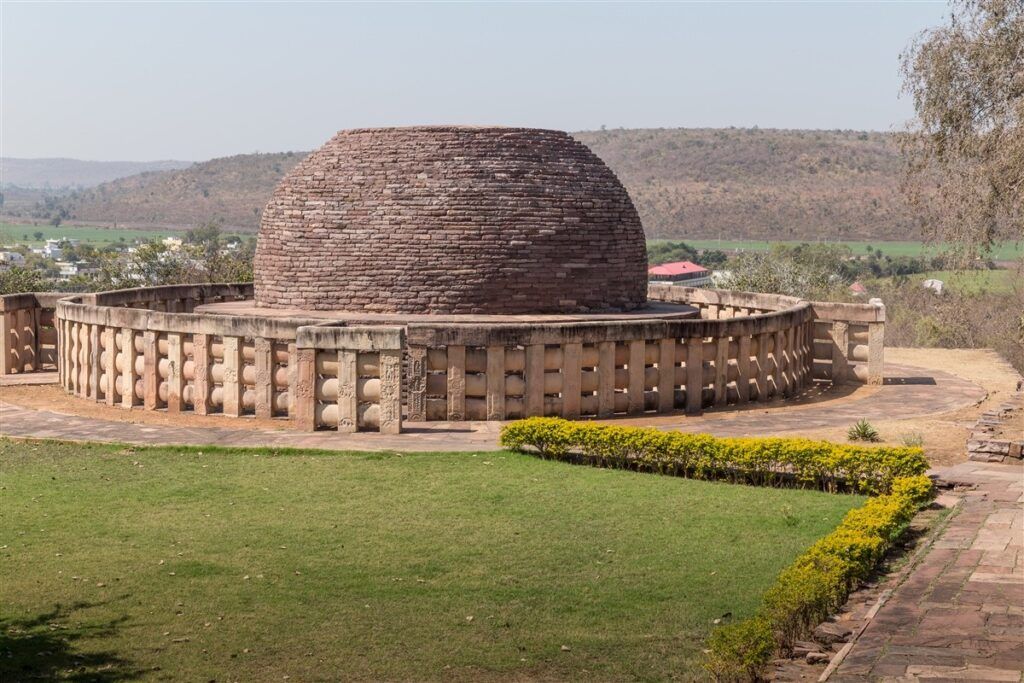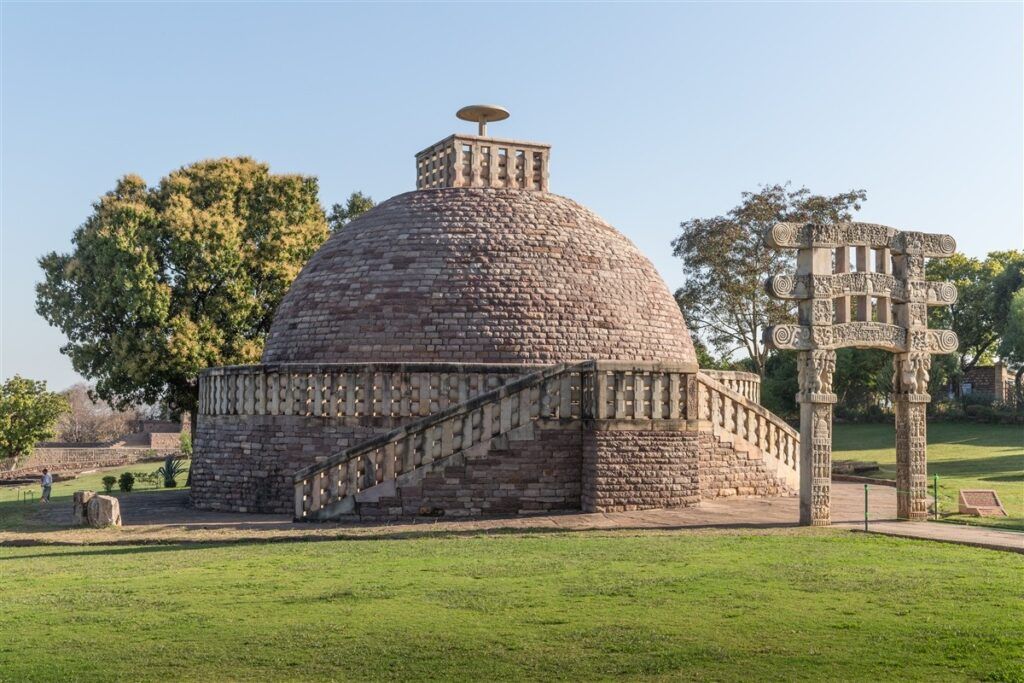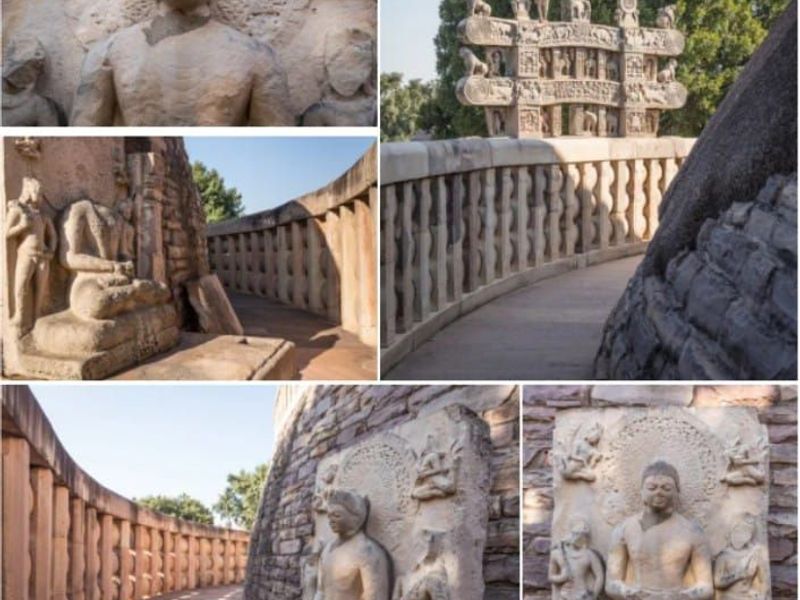The Great Stupas At Sanchi
One of the oldest stone structures in India was built by Emperor Ashoka in the 3rd century BCE. As a devoted patron of Buddhism, Ashoka put great care into its construction, ensuring intricate details in its design. He personally oversaw the project, and after his death, his wife Devi continued to maintain it. The primary purpose of the stupa was to preserve and spread the teachings of Buddhism. It is believed Sanchi was chosen for its construction as it may have been the birthplace of Ashoka. Originally, the stupa was built to house the relics of the Buddha and his disciples, making it a significant site in Buddhist architecture. Its carvings and sculptures beautifully depict stories from the Buddha’s life. The original structure was smaller but was enlarged during the Sunga period, about 50 years after Ashoka’s death. The concept of the stupa later spread across the Buddhist world, influencing structures in Sri Lanka, Java, Tibet, China, Korea, and Japan.
Architectural Feature
The stupa is a prime example of Buddhist architecture, reflecting the style influenced by the religion. Originally constructed from large bricks, it is believed that terraces at the base were once enclosed by wooden railings, later replaced by stone umbrellas during the Sunga period when larger versions were built using local sandstone. The hemispherical design of the stupa is thought to have originated from pre-Buddhist burial mounds. Its dome is adorned with a 'harmika,' a structure holding a triple umbrella or 'chhatravelli,' symbolising the Three Jewels of Buddhism: the Buddha, the Dharma, and the Sangha. The stupa stands on a circular base, supporting a massive solid dome, from which an umbrella projects.
At ground level, there is a path surrounded by stone balustrades. The structure also features four intricately carved gateways, known as toranas, added in the 1st century BC. These toranas are the architectural highlights of the stupa. Each torana has two vertical pillars and three horizontal bars, with sculptural decorations on both sides. The carvings depict significant symbols of Buddhism, historical events from Buddha’s life, and religious scenes. Interestingly, Buddha is represented symbolically, rather than in human form—appearing as a riderless horse, an umbrella, an empty throne, the Bodhi tree, or footprints. Each gateway entrance also features stone sculptures of Buddha. The southern gateway is renowned for its aesthetic proportions, structural balance, and features a depiction of the Ashoka pillar. Dedicated by the guild of ivory carvers from Vidisha, the inscription reads: 'Vedisehi dantakarehi rupadamam katam,' meaning "The ivory carvers from Vidisha have done the carving."
Sanchi Stupa I
Stupa 1 (image source: Kevin Standage)
At the heart of Sanchi lies the magnificent Stupa 1, a sacred monument rich with history and symbolism. This hemispherical dome spans about 36 metres in diameter and rises over 16 metres in height. Built by Emperor Ashoka, it stands as the first and most prominent stupa at Sanchi. Originally constructed from large bricks, the stupa was later encased in local sandstone, reflecting the architectural transition from wood to stone. Over time, the structure evolved, with stone encasing, pathways, and balustrades added, along with modifications in the mid-2nd century B.C. such as terraced stairs and additional balustrades, finally in the 5th century A.D., four monumental Buddha images were installed, embodying a sense of quiet meditation and spiritual sanctity. It serves as a powerful symbol of the Buddhist era and the enduring values of Buddha.
Sanchi Stupa II

Stupa 2 (image source: Kevin Standage)
Situated on a serene artificial terrace, it exudes a sense of quiet isolation, with intricate carvings dating back to around 115 B.C. These carvings offer some of the earliest and most captivating examples of Buddhist stone art. The balustrades display a remarkable array of decorative motifs, including depictions of flora, fauna, and figures that reflect the spiritual and symbolic world of early Buddhist culture. Animals such as elephants, lions, and horses are carved into the stone, with horsemen using stirrups – considered the earliest known representation of stirrups in Indian art. Stupa also features demigods, human figures, and a blend of real and mythological creatures. A relic chamber within the stupa contains a sandstone box with inscribed caskets, an important discovery shedding light on the ancient Indian cult of relic worship. The relics, attributed to ten saints, highlight the reverence not only for the Buddha but also for his disciples, including Kasapagota, Majhima, and Mogaliputa. This tradition of enshrining saintly remains suggests a growing evolution in the Buddhist practice of relic worship.
Sanchi Stupa III

Stupa 3 (image source: Kevin Standage)
It is located just north of Stupa 1 and mirrors many architectural elements of its neighbour. While its gateway is not as grand, it shares several design motifs and principles with Stupa 1. The balustrades of Stupa 3 offer a unique glimpse into the intersection of art and history, with inscriptions revealing that the stairway balustrades of both Stupas were donated by the same individual, highlighting a unified vision in their construction. One of the most remarkable discoveries at Stupa 3 was the relics of the Buddha’s foremost disciples, Sariputra and Maudgalyayana, uncovered by Alexander Cunningham during his excavation. Sariputra’s casket contained fragments of bone alongside beads made from precious materials like pearl, garnet, lapis lazuli, crystal, and amethyst, adding a layer of symbolic reverence. Similarly, Maudgalyayana’s casket held two bone fragments, inscribed and encased with equal sacred care. These relics emphasise the spiritual significance of Stupa 3 as a revered site.
In Conclusion,
The present site of Sanchi was rediscovered and preserved under the guidance of Sir John Marshall, then Director-General of the Archaeological Survey of India. In 1989, the Great Stupa and other Buddhist monuments at Sanchi were recognised as a UNESCO World Heritage Site. The architecture of Sanchi continues to inspire modern architects, with its influence evident in various buildings across India today.
To learn more about Indian art and artists, download the Rooftop app from the App Store or Google Play to stay updated on our upcoming art events and workshops. Stay tuned to rooftop blogs and follow us on @rooftop_app.
By Shrushti Patel
